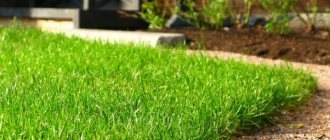Water dissolves the nutrients present in the soil. Plants absorb this solution with their roots to ensure vital functions. Therefore, regular, proper watering is extremely important to maintain a bright and velvety lawn. The frequency and abundance of moisture depend on the climate of the region, the season of the year and the species composition of lawn grasses.
It is worth paying attention to the quality of water used for irrigation. Automatic watering systems will greatly facilitate the care of the local area.
Water requirements
There are several ways to obtain water to moisturize lawn grass.:
- Install rainwater collection tanks. Rainwater is free of mechanical impurities and is heated in containers to ambient temperature.
Watering with natural water is beneficial for plants.
- Water intake by a submersible pump from a natural reservoir - river, lake. It is necessary to take into account the presence of impurities and the chemical composition of the water.
- Drawing water from a well or well on the site. This water has a temperature below 10°C. If you water it right away, the root system will be in shock. To avoid unpleasant consequences, water that is too cold is first collected in a container, where it is heated to 15°C.
- Water from the central water supply is characterized by high hardness and impurities of metal particles. It is advisable to filter tap water.
note! Water quality control is especially important when watering by hand. Automatic systems already have cleaning filters.
Signs of lack of moisture
For healthy growth of lawn grass, it is important to maintain systematic watering. Flooding an area is just as dangerous as not watering it often enough.
The first signs that the grass is not getting enough moisture are as follows:
- the lawn began to be “trampled down” (the grass almost does not rise after it has been crushed);
- the grass begins to curl;
- color changes from rich green to brown;
- bald spots appear on the area;
- the grass begins to wither or turn yellow.
Some varieties of plants remain alive even when the blades of grass have dried out, since their root system goes into a dormant state until the next watering. However, dried grass will not become young and green again. Lawn owners will have to wait for a new one to grow.
When to start after winter?
The main melting of snow occurs at the end of March. It is necessary to ensure uniform melting by distributing piles of snow and snowdrifts throughout the area. At the same time, movement on damp lawns is minimized. If a drainage system is installed on the lawn, melt water will not stagnate. In this case, drains and drainage wells are cleaned.
How to determine a favorable time?
Watering in spring begins when stable warm weather begins from +15°C. Moistening the soil in cold weather at temperatures below +10°C will not bring any benefit . Usually the first spring watering is combined with fertilizing with mineral fertilizers. Water will dissolve the granules and prevent the first tender greenery from “burning” in the April sun.
general information
The topic of watering probably raises more questions than any other area of garden care - even more than choosing a quality fertilizer, although proper fertilizing is also very important.
Not everyone is concerned about how to water their lawn grass correctly. Many owners believe that everything is simple: if you water too little, it’s bad; If you water often and a lot, it’s the opposite. But when it comes to irrigation, bigger is not always better.
Watering the lawn
Many little things play an important role in this problem. To effectively irrigate a lawn, there are many conditions and factors that ultimately decide what kind of lawn it will be: green and shining or pale and yellow. Here are some of the factors that should not be forgotten:
- Feed pressure;
- Soil holding capacity;
- The depth at which the grass is planted;
- Water evaporation rate;
- Duration of watering;
- Grass type: warm-season grass or temperature-tolerant grass;
- Grass resistance to drought.
Note! The type of soil in your yard will affect how quickly moisture will penetrate and seep into the soil.
In clay-type soil (soil that is very dense leaving little room for air), water slowly penetrates and percolates through the dense soil. The middle surface of the sprinkler can deliver liquid faster than the soil can absorb it. This creates runoff and puddles in areas where the lawn is lower in level.
On the other hand, when water is poured onto sandy soil, it quickly seeps through the soil and does not have time to irrigate the lawn.
But it is also equally important to determine the required supply pressure to ensure proper penetration of water into the soil.
Additional Information! To find out what the composition of the soil is, you should simply dig a hole in the yard one hundred centimeters deep. This will help determine the water supply schedule, the time and duration of watering, so as not to waste unnecessary resources, not to create puddles in the yard, and at the same time, to prevent the grass from dying from lack of moisture.
Periodicity
Lawn grass care begins immediately after planting.
Early lawn planting occurs in the second half of April - early May. Watering of the roll variety begins already during planting, especially if the lawn is large. Moisture will revive dried roots and help plants take root in a new place.
Newly sown seeds are watered with a sprinkler so that the seedlings are not washed out of the soil.
If the entire first week after planting is dry, without rain, then moisten the lawn field daily. Irrigate in the morning and evening, evenly distributing the daily water intake. From the second week you can water every other day, and from the third - every 2 days. In the first weeks, young grass is watered little by little but often.
Features at different times of the year
When the root system takes root well, the watering regime will stabilize. The main points of hydration are reflected in the table.
| Season | Normal weather | Rainy weather | Dry weather |
| Spring | 2 times per week | Once a week | 3 times a week |
| Summer | In one day | Once a week | Every day |
| Autumn | Once every 10 days | Once every 2 weeks | Once a week |
The frequency of watering the lawn is influenced by the composition of the soil and the species characteristics of lawn grasses. There are drought-tolerant options that require less moisture . Excessive moisture is also dangerous - excess water serves as a medium for the development of mold and other fungi.
At different times of the day
The best time of day for watering is considered to be early morning, before the sun has yet risen.
Cool and windless weather will allow moisture to saturate the soil, drops of water will dry on the leaves before the scorching sun appears. The evening procedure is carried out between 16 and 18 hours . The hot sun is no longer there, but it is still warm enough for the water to be absorbed and the grass to dry out. Moisture remaining overnight will overcool the plants and promote fungal infections.
Daytime watering can be carried out, but only on cloudy, warm days without sun. As a rule, such days fall at the end of summer or beginning of autumn.
Summer midday watering is extremely undesirable; the leaves will get burned.
How to determine when to water?
A lawn suffering from a lack of moisture shows the following signs::
- the leaves darken, curl, and become withered;
- the grass loses its elasticity; if you crush the plants, they will take a long time to restore their shape;
- the color of the grass changes from green to yellowish, and in severe drought - to brown;
- decreased resistance to trampling leads to the formation of bald spots;
- the surface of the lawn becomes not velvety to the touch, but prickly.
The first to respond to the scarcity of moisture are white bentgrass and common bluegrass . Relatively resistant are ryegrass, fescue and meadow grass.
Haircut rules: from early spring to autumn
Regular mowing not only allows you to create an aesthetically attractive surface, but also ensures the normal growth and development of lawn grasses. The grass should not be allowed to grow higher than 8-10 cm - it is important to maintain a regular cutting height of about 4-5 cm. The exception is the first spring mowing, carried out after the grass height reaches 10-12 cm (tender young grass is allowed to grow) and the mowing height set in such a way as to cut off no more than 2-3 cm, that is, about 8-9 cm. After a week, it will be possible to cut the lawn to the usual height.
Recommended regular cutting height is 4-5 cm
Subsequent mowings are carried out when the grass has grown by 2-3 cm, but it is advisable not to cut off more than 1/3 of the length of the grass, otherwise the plants experience severe stress, become weakened, less attractive and more vulnerable to pests and diseases. Continue regular mowing as long as the grass grows. At the last mowing, a taller grass stand is left for better overwintering (2 cm more than the regular height).
How to mow a newly sown lawn
A young lawn is cut a little differently in the first year of its life. Before moving to a regular mowing height, young seedlings need to be allowed to grow stronger and form a thicker cover. Below is a useful diagram for mowing a seeded lawn in its first year.
Mowing the seed lawn in the first year of life
By implementing this scheme, you will get a well-formed green surface in one year. In the first year, fertilizing will not be necessary, provided that you applied all the necessary fertilizers when preparing the site.
Many summer residents sow a lawn in the spring, but some experts recommend laying a lawn in August. Sowing technology and all the arguments in favor of this sowing period are in the article
August is lawn time
.
Scheme
A medium to small area of lawn can be watered with a regular garden watering can. A garden hose without a nozzle, but with the neck pinched with your finger, will speed up the process. However, the following devices will help significantly facilitate care:
- a perforated hose with many holes along its entire length moves across the lawn and covers a large area;
- sprinkler - a nozzle on a hose that converts a strong stream of water into small drops that do not erode the soil surface;
- a circular sprinkler resembles a miniature fountain; a set of several devices is suitable for watering a fairly large area;
- The rotating sprinkler allows you to regulate the pressure of the jets and adjust the watering distance.
Automatic lawn irrigation systems are designed individually, based on the irrigation area, soil composition, and plant type. May have varying degrees of complexity and autonomy. Such systems are installed by professionals even before the lawn itself is laid.
COST OF WATERING THE AREA
| Plot area, m2 | Price, thousand rubles |
| 200 | 60 |
| 400 | 80 |
| 600 | 120 |
| 800 | 160 |
| 1000 | 200 |
| 1200 | 240 |
| 1400 | 280 |
| 1600 | 320 |
| 1800 | 360 |
| Carrying out planned conservation for the winter period | 7 |
| pre-season launch of the automatic watering system after winter | 5 |
| System diagnostics and unscheduled maintenance | 2 |
| Warranty repair of automatic watering system | FOR FREE |
For plots with an irrigated area of less than 20 acres, the average price is about 20 thousand rubles. per hundred. In the calculations below, it is the irrigation area that is indicated, and not the total area of the plot.
How much water is needed: consumption rates per m2
The amount of water per square meter of lawn area is determined by the time of year, the composition of the soil and the type of lawn vegetation. Based on the approved standards for central Russia, 1 m2 of lawn plantings consume 4-6 liters of water per irrigation, of which there can be several per day.
Features of calculation by season
The given standards are adjusted according to the seasons of the year. In the heat of summer, the irrigation rate on light sandy soils increases to 20-40 liters of water per square meter, but not at once, but over the course of a whole day. On loamy soils with a moderate rate of moisture filtration, 12-13 l/m2 are consumed per watering three times a week. Clay soils with low water filtration rates require watering once a week, using 35-40 l/m2.
The norm for spring watering is 15 liters of water per m2 of newly planted lawn. Further, to maintain the proper level of humidity, while it is still cool and the ground is saturated with melt water, 25 l/m2 per week is enough.
In autumn, during dry weather, water the lawn once a week, spending 10-15 l/m2. The volume of water for irrigation is gradually reduced and is carried out every 10-14 days. The last watering occurs at the end of September - beginning of October. Experienced gardeners combine autumn moisture with the application of complex mineral fertilizing.
Features of fertilizing the lawn in summer
The main task of summer lawn fertilizing is to maintain active grass growth, give it a healthy appearance and rich color, and also increase its drought resistance.
That is why in the summer your green “carpet” needs a heavy dose of nitrogen and potassium fertilizers and only a small amount of phosphorus.
| Element | What is it needed for | If there is a shortage | In case of excess | Application rates |
| Nitrogen |
|
|
| 15-20 g of ammonium nitrate per 1 sq.m or 15-20 g of urea per 1 sq.m after every second mowing of the lawn from May to early August and once at the end of August - September |
| Phosphorus |
|
|
| 100 g of bone meal per 1 sq.m. or 15-20 g of superphosphate per 1 sq.m. once a summer |
| Potassium |
|
|
| 15-20 g of potassium salt per 1 sq.m. twice a summer |
Of course, the easiest way is to apply complex fertilizers, the composition of which is carefully selected by specialists. This will ensure your lawn is getting all the nutrients it needs.
It is preferable to feed the grass with long-acting complexes (Floranid, Compo Duratek, Bazakot, Florovit, etc.). The granules of such fertilizers are partially coated with insoluble resins, due to which nitrogen is released gradually. Thanks to this, the lawn grows thick, uniform, and without bald spots. Typically, fertilizing is carried out once every 1.5-2 months.
When to stop and why?
Watering in central Russia stops completely in the first ten days of October. In the southern regions, the deadline is shifted to the end of October, and in the northern regions they stop watering at the end of September. Plants are preparing for winter, the temperature of the surrounding air and soil decreases, and natural humidity increases.
At this stage, it is necessary to strengthen the root system so that it safely survives the winter and gives rise to the growth of the above-ground part in the spring. Therefore, the lack of moisture inhibits the development of vegetative green mass and allows the root system to make a reserve for the next season.
Additional care
There are several situations in which the lawn requires additional care in the form of watering, regardless of the air temperature, namely:
- After each mowing, you must first remove all the cut grass using a rake, and then thoroughly water the area. This should be done in order to give the lawn a fresh and clean look, as well as to help the plants recover after cutting.
- After fertilizing the grass with dry substances that are physically unable to be absorbed by the roots without moistening the soil, it is watering that helps the fertilizing be completely absorbed by the root system of the plants. When using fertilizers diluted in water, such as urea, additional watering is not necessary.
How does a garden automatic watering system work?
1. The garden watering system is configured once using the control unit. A specialist sets up automatic garden watering in accordance with your wishes. He will also recommend to you which settings are best to make.
2. Automatic watering of the garden begins to work adhering to the specified parameters. For each irrigation zone of a personal plot, you can set a separate operating time as well as a switching period.
3. The computer takes into account external temperature, relative humidity, weather and daily time. If it rains, you will not need to manually turn off your garden irrigation system or adjust the irrigation duration yourself. The computer will change its settings automatically.
Mulching turf
To protect plants from weeds, drying out or waterlogging, sudden temperature fluctuations and other unfavorable external factors, gardeners use such a popular agricultural technique as mulching.
It consists of applying a special layer of any organic material (peat, hay, sawdust, compost, agrofibre, etc.) to the surface of the earth with growing crops. This method gives the following effect:
- retains soil moisture, so you can reduce the frequency of watering;
- protects the root system from harmful weather conditions: heat, frost, winds;
- prevents plant rotting;
- regulates soil acidity;
- prevents the spread of weeds;
- retains nutrients in the soil and additionally fertilizes it during the process of decay;
- smoothes the surface.
Mulching is carried out only on dry soil, without compacting. First, the soil must be loosened and cleared of weeds. The material is laid out in an even layer 5–10 cm thick. For the lawn, mulching is used in two cases: immediately after planting the seeds and in the fall as a measure to prepare the coating for the winter period.











